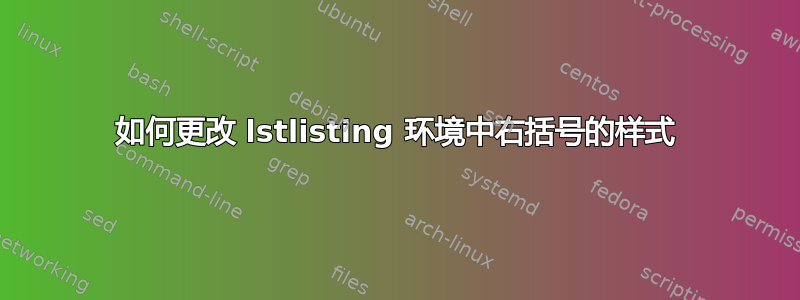
请考虑以下 MWE(摘自Antal Spector-Zabusky 答案):
\documentclass{article}
\usepackage[utf8]{inputenc}
\usepackage[spanish]{babel}
\usepackage{color}
\usepackage{listings}
\definecolor{codegreen}{rgb}{0,0.6,0}
\definecolor{codegray}{rgb}{0.5,0.5,0.5}
\definecolor{codepurple}{rgb}{0.58,0,0.82}
\definecolor{backcolour}{rgb}{0.95,0.95,0.92}
\lstdefinestyle{miestilo}{
backgroundcolor=\color{backcolour},
commentstyle=\color{codegreen},
numberstyle=\noncopynumber,
numberstyle=\tiny\color{codegray},
keywordstyle=\color{magenta},
stringstyle=\color{codepurple},
basicstyle=\scriptsize,
breakatwhitespace=false,
breaklines=true,
captionpos=b,
keepspaces=true,
numbers=left,
numbersep=5pt,
showspaces=false,
showstringspaces=false,
showtabs=false,
tabsize=2
}
\newcommand{\CodeSymbol}[1]{\bfseries\textcolor{red}{#1}} % Code associated to defining styles
\lstset {%
columns=fullflexible,
keepspaces=true,
style=miestilo,
language=C++,
literate=%
{\&}{{\CodeSymbol{\&}}}1
{<}{{\CodeSymbol{$<$}}}1
{(}{{\CodeSymbol{(}}}1
{)}{{\CodeSymbol{)}}}1 % This DOES NOT work good
}
\begin{document}
\begin{lstlisting}
Example: & works good, < and ( too...
(...)
\end{lstlisting}
\end{document}
如果可能的话,我想用同样的方式改变右括号的颜色。无论如何,用这种方法对我来说是不可能的。
我想我已经尝试了所有的可能性:
{\)}{{\CodeSymbol{\)}}}1 % Does not work
{)}{{\CodeSymbol{$)$}}}1 % Does not work
{)}{{\CodeSymbol{\)}}}1 % Does not work
{$)$}{{\CodeSymbol{$)$}}}1 % Does not work
% ...
但这些都不起作用。
我也看了手册,但什么也没找到。
如何解决?
谢谢你!!
编辑:它也不适用于/。
编辑2:它也不起作用.。
答案1
使用
\lstdefinestyle{miestilo}{
backgroundcolor=\color{backcolour},
commentstyle=\color{codegreen},
numberstyle=\noncopynumber,
numberstyle=\tiny\color{codegray},
keywordstyle=\color{magenta},
stringstyle=\color{codepurple},
basicstyle=\scriptsize,
breakatwhitespace=false,
% breaklines=true,
captionpos=b,
keepspaces=true,
numbers=left,
numbersep=5pt,
showspaces=false,
showstringspaces=false,
showtabs=false,
tabsize=2
}
这个选项有点可疑……
答案2
我不知道这是为什么,但这里有一个不太好的解决方案。只需在括号前添加另一个符号,~如下例所示,这似乎有效。
\documentclass{article}
\usepackage[utf8]{inputenc}
\usepackage[spanish]{babel}
\usepackage{color}
\usepackage{listings}
\definecolor{codegreen}{rgb}{0,0.6,0}
\definecolor{codegray}{rgb}{0.5,0.5,0.5}
\definecolor{codepurple}{rgb}{0.58,0,0.82}
\definecolor{backcolour}{rgb}{0.95,0.95,0.92}
\lstdefinestyle{miestilo}{
backgroundcolor=\color{backcolour},
commentstyle=\color{codegreen},
numberstyle=\noncopynumber,
numberstyle=\tiny\color{codegray},
keywordstyle=\color{magenta},
stringstyle=\color{codepurple},
basicstyle=\scriptsize,
breakatwhitespace=false,
breaklines=true,
captionpos=b,
keepspaces=true,
numbers=left,
numbersep=5pt,
showspaces=false,
showstringspaces=false,
showtabs=false,
tabsize=2
}
\newcommand{\CodeSymbol}[1]{\bfseries\textcolor{red}{#1}} % Code associated to defining styles
\lstset {%
columns=fullflexible,
keepspaces=true,
style=miestilo,
language=C++,
literate={\{}{{\CodeSymbol{\{}}}1
{\}}{{\CodeSymbol{\}}}}1
{(}{{\CodeSymbol{(}}}1
{~)}{{\CodeSymbol{)}}}1
{>}{{\CodeSymbol{$>$}}}1
{=}{{\CodeSymbol{$=$}}}1
{;}{{\CodeSymbol{$;$}}}1
}
\begin{document}
\begin{lstlisting}
Example: & works good, < and ( too...
(...~)
\end{lstlisting}
\end{document}
这里还有另一条评论:如果你从其他地方获取代码,披露消息来源总是更好的。





